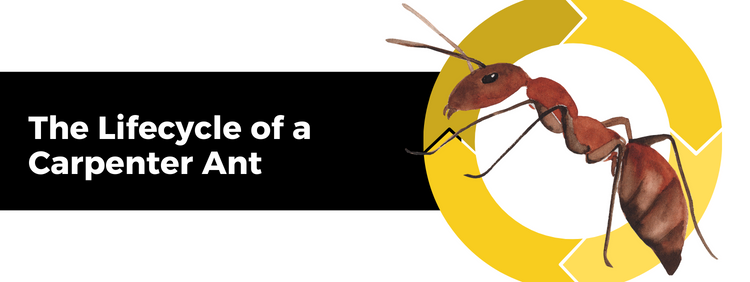Cambridge Pest Removal: The Lifecycle of a Carpenter Ant

Infestations of carpenter ants are fairly common and can be devastating to the structural integrity of a building if it has a wooden structure. Carpenter ants can hollow out supports by digging tunnels for their nests. Carpenter ant control in Cambridge can get rid of the insects but does not reverse the damage, which can be expensive to fix. Understanding the life cycle of a carpenter ant may help you avoid an infestation in the first place.
Lifespan
How long an individual carpenter ant lives depends on its role in the colony. Most ants only live a matter of weeks or a few months at most. The queen is the only egg-laying member of the colony and is responsible for maintaining its population. If the queen dies, the rest of the colony will eventually die off too. For this reason, the queen’s lifespan is many times longer than that of the other members of the colony, extending over years and possibly decades.
Nuptial Flight
When a colony has been established for about two to six years, the queen hatches a new generation of male and female ants with wings. These ants are called swarmers, and their job is to start new colonies elsewhere. When these winged ants take off and fly away, it is called the nuptial flight because the male and female ants will mate with each other in the air. After the nuptial flight, the male ants have served their purpose and soon die off, while the females fly away and look for new nesting sites.
Carpenter ants nest in wood. They look specifically for wet or rotted wood because it is soft and easy to chew through, which is how carpenter ants make their tunnels. A new nest typically begins when the female ant, now the new queen, crawls through a crack in the wood and starts laying eggs inside.
Eggs
Most of the work of an ant colony is performed by sterile, female, worker ants. The nuptial flight is important because only fertilized eggs can produce females. Unfertilized eggs mature into males, and only a few of these are needed because their own job in the colony is to fertilize the queen.
When a new queen establishes a nest, she seals herself inside the chamber where she lays her eggs and waits for them to hatch. During this time, she can draw on reserves of stored fat for nourishment as well as her remaining wing muscles since she no longer has any need to fly.
Larvae
When the first generation of eggs hatches, the queen feeds her young by producing food for them from her salivary glands. Once the larvae mature, they will become workers that forage for food for the colony. Once there are workers to care for the young, the queen will no longer nurture the larvae herself. From that point on, her job is strictly to mate and lay more eggs.
Metamorphosis
Like bees and butterflies, ants go through a complete four-stage metamorphosis before they become adults. Once the larvae are mature enough, they enter a pupal stage and spin a cocoon in which they undergo the final maturation process. When the pupal stage is over, which takes up to 10 weeks, they emerge as fully mature adults ready to assume their role in the colony.
Why You Should Call Truly Nolen for Carpenter Ant Control in Cambridge
Our trained technicians can identify whether you have carpenter ants or another type of pest, such as termites. This is important to create an effective plan of action. Find out more about our carpenter ant services.